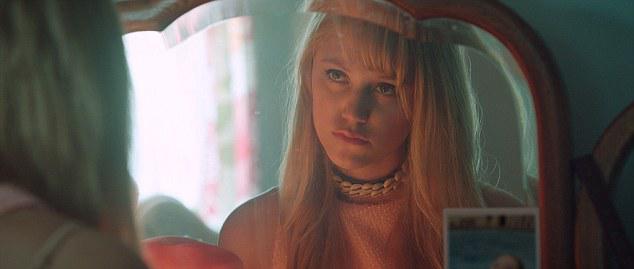Spoilers ahead.
The first thing you’ll want to do you after you see It Follows is to tell other people to watch it immediately. The movie, which has quietly become a horror event, is so clever, and so genuinely scary, that it demands to be experienced with others.
But there’s a problem. When you recommend it, people will ask what it’s about—and on its own, the premise sounds absurdly retrograde. The film centers on Jay (Maika Monroe, reprising final girl duties after The Guest), who drifts through manicured Detroit suburbs in an uncertain adolescent haze. She’s seeing a boy, who seems sweet, if a little peculiar: At one point, on a date in a historic movie house, he suddenly asks to leave after pointing out a woman in a yellow dress, refusing to say why. Still, Jay is smitten, and she sleeps with him in his car in an abandoned parking structure. It’s more romantic than it sounds—at least until she wakes up tied to a wheelchair while her suitor goes on a paranoid-sounding rant about something following him. He passed it on to her when they had sex, he explains, and now she has to pass it on to someone else—or it will come for her.
“Really?” people will invariably respond. “It’s about a walking STD?” The whole thing sounds like a hilariously literal apex to the long tradition of teen horror movies that punish sexual activity as an offense more grave than any other. The movie’s press materials have been amusingly coy in this vein, referring only to a sexual encounter and a menace that presents itself afterward.
Here’s the thing: In the uniquely capable hands of writer-director David Robert Mitchell, It Follows is not only heart-stoppingly scary, it’s also one of the most humane and emotionally complex horror movies I can recall. And the premise belies the film’s vision of another of life’s terrors, one that can’t be defeated by any prophylactics—more on that in a moment.
After her assault, Jay is clearly in shock. But over time, we sense a young woman not only coming to terms with her new follower but also developing a level of agency that’s rare among other teen horror heroines. Part of that is because, as Mitchell told me over the phone last week, he never really set out to write a final girl. “Choosing a female protagonist is certainly a nod to that tradition of horror movies,” he said. He’s been a “voracious” consumer of horror movies since he was a kid, and the ghosts of his beloved Universal monster movies and old-school Romero are certainly here. But Mitchell said that instead of channeling those movies directly, he approached the film in much the way he did his debut The Myth of the American Sleepover, a gentler coming-of-age tale that shares It Follows’ lyrical prism on the adolescent experience.
“I tried to spend a lot of time getting to that headspace,” he said. “I try to care about each of the characters. There are aspects of myself in Jay, and in all of them.”
His labors are clear in the movie, with its contemplative voiceovers and ensemble of carefully drawn teenagers with their own voices and anxieties. Despite the large cast, no characters exist solely as monster bait. More than any slasher movie, It Follows recalls the vibe of My So-Called Life, only with Angela, Rayanne, and Rickie trying to outsmart a deeply kinky demon.
Monroe, who was born in 1993, also grew up on a steady diet of horror movies (one of her earliest cinematic memories is her father showing her The Shining), but she said she too never saw Jay as any kind of heir to the scream-queen throne. Mitchell guided her in a more nuanced direction (“David is so specific about everything,” she said), and she seemed to view her character’s inner turmoil as the movie’s central tension. “You meet [Jay] in normal circumstances, and she becomes terrified, [then] she grows up,” she said. “I wanted to make it as real as possible.”
In this way, Mitchell and Monroe infuse old horror tropes with a more universal appeal than we’ve become accustomed to. “While embracing some clichés,” he said, “I want to make my version of many different kinds of films, including horror.”
And that brings us back to the elemental, usefully crude premise. Jay eventually does fulfill the myth’s prerogative, taking control of her fate and passing on the “virus,” but by then she’s realized the menace can’t be outrun. What she’s really fighting, along with all the characters, is an emerging sense of her own mortality. Toward the end of the movie, a character quotes a passage from a hospital bed about how “the worst thing is certain.” She reads:
When there is torture, there is pain and wounds, physical agony, and all this distracts the mind from mental suffering, so that one is tormented by the wounds until the moment of death. And the most terrible agony may not be in the wounds themselves but in knowing for certain that within an hour, then within 10 minutes, then within half a minute, now at this very instant—your soul will leave your body and you will no longer be a person, and that this is certain. The worst thing is that it is certain.
A little on the nose, maybe—I don’t know many teenagers who quote Dostoevsky—but not a bad way to sum up the movie’s literal and figurative horrors.
